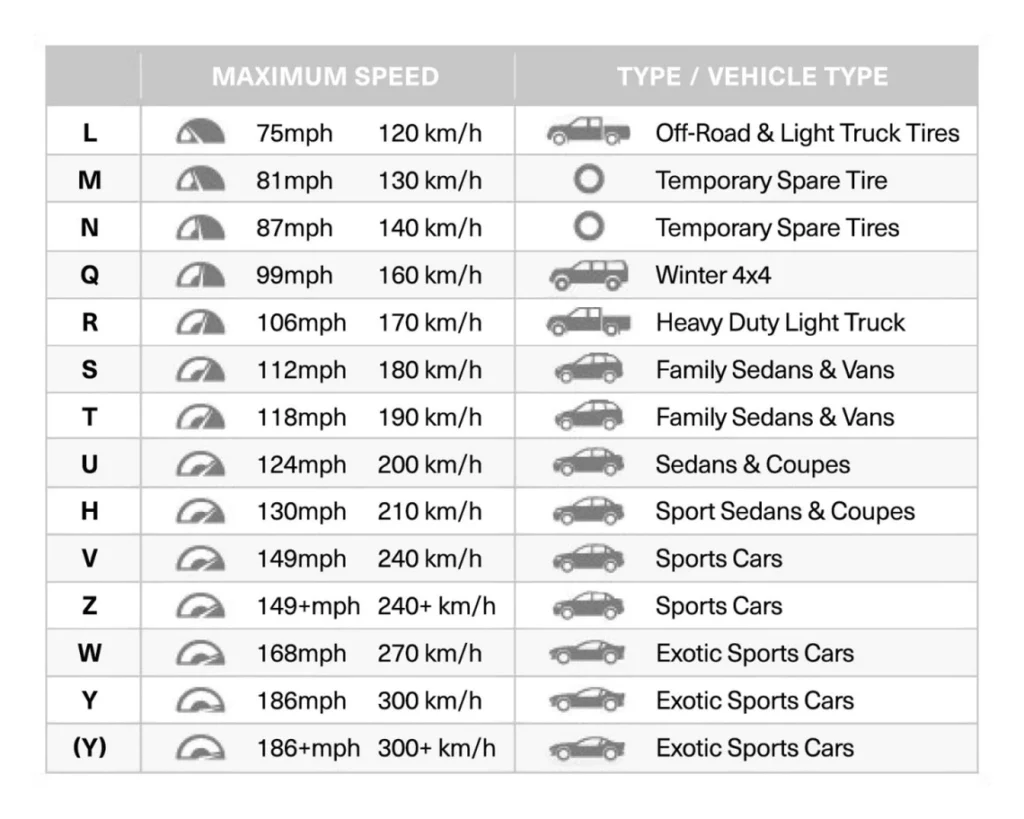If you own your car for long enough, you’ll need to replace your Tires at some point. And if you have a blowout or an unfixable flat, it could come sooner than you want. It all sounds simple enough — until you have to figure out what size and type of Tires you need.
The information listed on the side of your Tire can be intimidating. It’s an assortment of cryptic letters and numbers. But with the right information, you can easily translate your tire’s code into useful information.
Where to Find your Vehicle’s Tire Size
Before you can decode your car’s Tire Size, you have to find where it’s located. Most vehicles have the information listed on both a Tire placard and data decal — the sticker where the VIN is printed — inside the driver’s door jamb.
|
| Tire Sticker located on the door jamb |
The size will also be listed on the Tire’s Sidewall. But be aware that the mounted size may vary from what the car originally came with. If you’re replacing all four, it’ll likely be smart to go with what the sticker says.
How To Read Tire Sizes
Most cars on the road these days have a metric Tire Size. Take a Tire that reads P205/65 R15, for example. The coding breaks down like this:
 |
| Tire Size Guide |
P: The letter “P” indicates a P-Metric Tire, designed for passenger vehicles. A type of “LT”, indicates the Tire is designed for light trucks. If there’s no letter, it means the Tire is Euro-metric — that’s a slightly different measurement system than P-Metric, though similar enough that Tires with the same size, load and speed rating are usually interchangeable.
205: The Tire width is the three-digit number listed before the slash mark. In our example, the 205 indicates a width of 205 millimeters.
65: You’ll find the Tire’s aspect ratio listed right after the forward backslash. A ratio of 65 indicates the height of the Tire is equal to 65% of its width. A larger aspect ratio equates to a larger sidewall.
R15: The final three characters are the Wheel size. “R” stands for radial, although it’s often mistaken for rim. The 16 indicates the Tire is made for a wheel with a 15-inch diameter.
What are load and speed ratings?
Following the Tire size, you’ll find the load and speed rating. For instance, our P205/55 R16 tire may have the characters 91 S listed after the Tire size.
91: This is the Tire’s load rating. The 91 correlates to a measurement in pounds (in this case, 1,356 pounds), listed on the standardized load index table below. This is the maximum load the Tire can support when properly inflated.
 |
| Load Index And Load in Lbs. |
S: Next, we have the Tire’s speed rating, which indicates its maximum speed capability. In this example, the “S” implies a speed rating of 112 mph. Like load ratings, speed ratings are listed on a standardized chart. Letters near the beginning of the alphabet are associated with a lower speed capability than those near the end.
 |
| Speed-Rate Chart |
What’s a DOT number?
Also listed on the sidewall, you’ll find the U.S. Department of Transportation (DOT) number. Federal law requires that this code is listed on all Tires. It’s often used by manufacturers when performing a recall.
 |
| DOT Information on the Tire Sidewall |
But understanding the DOT number can be useful for consumers as well. Say, for example, you have a Tire with 1TBXPFD5C4623 stamped into the sidewall.
The first eight characters aren’t of much interest. They’re a manufacturer-specific code indicating build characteristics like the factory location, Tire size and Tire construction. It’s the final four digits we’re interested in. These characters signify the week and year the tire was made. In our example, 4623 indicates the 43rd week of 2023.
What are UTQG ratings?
Another tidbit of information found on the tire’s sidewall is the Uniform Tire Quality Grading (UTQG). This code provides information qualities such as Treadwear, Traction and Temperature.
 |
| Uniform Tire Quality Grading “UTQG” Information |
The Treadwear rating is based on standardized government tests. It’s designed to predict the life of a tire. For example, a tire with a Treadwear rating of 300 should last three times longer than one with a grade of 100. The problem is, these ratings are assigned by the manufacturer and not a third party. So, results may vary.
Traction grades are labeled AA, A, B and C. A tire with a rating of AA has the best traction, whereas one with a score of C has the worst.
Temperature grades indicate a tire’s ability to withstand the heat created at high speeds. The ratings are A (safe up to 115 mph), B (safe between 100 and 115 mph) and C (safe between 85 and 100 mph).
How to tell when you need new tires
The conventional wisdom from most Tire authorities is to replace your tires when they have 2/32 of an inch of tread left.
There are a few ways to tell if you need New Tires, but here’s a quick one: Take a penny and pinch Lincoln’s body between your fingers, then put his head down into the tire tread. If any part of Lincoln’s head is obscured by the tread, you’re OK. But if you can see the top of Lincoln’s hair, or where it says “In God We Trust,” it’s time for you to get new tires.
 |
| Penny Coin Tread Depth Trick |
Then again, if you don’t drive very much — say, only a couple thousand miles a year — your tires might age out before their tread wears down. If this sounds like your situation, the safest course is to start checking for cracking, drying and hardening when your tires reach five years old. If you’re not sure what to look for, ask a mechanic to check the tires’ condition annually. Once they hit 10 years, they should definitely be replaced.
 |
| Tire Tread Depth Wear Bars |




